By: Ron Hollis
Customer Support, Covington Aircraft
The customer exclaimed: “You mean all that was wrong with the engine was a dirty compressor!” Well, the dirty compressor wasn’t all that was wrong. However, it was the most significant thing causing his engine’s poor performance. The engine also needed a hot section inspection as there were several large cracks in the outside diameter of the engine’s large exit duct, and the gas generator speed indicator needed replacing. The deposits on the components of his compressor, and the resulting poor compressor efficiency, was making it necessary to add more fuel in order to obtain the performance he wanted at altitude. This was resulting in high T-5 or inter-turbine temperatures.
I quizzed him about his practice regarding compressor washes, and he informed me that he was not having compressor washes done. Someone had told him compressor washes weren’t necessary, and may even be detrimental to the health of the engine. Not everyone agrees whether or not compressor washes are beneficial or necessary. Some of the confusion results from a “bathtub ring” type deposit that is sometimes spotted in gas generator cases during hot section inspections. These are caused by soap deposits left following a compressor performance recovery wash. The soap solution wasn’t effectively rinsed out or allowed to quickly drain from the engine following the wash. Such rings are unsightly, but our experience indicates they are not necessarily a detriment to the health and serviceability of the engine.
It is our recommendation that you have a compressor wash done when it is needed. When is it needed? When your maintenance provider is checking for Foreign Object Damage (FOD) to the compressor, and notes the compressor is dirty, grimy, or when the engine’s gas generator speed and T-5 temperatures indicate the need (high gas generator speed and high T-5 temps for a given torque value indicate the need for a compressor wash, a “cold section” problem).
The secret to successful compressor washes is to use a good soap and good water (Pratt & Whitney approved). The maintenance manual says drinking water can be used. However, drinking water where I was raised would turn orange in the glass when left to set for an hour. It was so loaded with minerals that it would have been a disaster to use it to wash a compressor. Instruct your maintenance provider to use distilled water if he isn’t confident his water supply is mineral free. The compressor should be rinsed following a performance recovery wash until it’s apparent there is no more soap present.
If your aircraft engines aren’t equipped with the factory compressor wash ring, it is possible to use a hand-held wash ring manufactured using drawings contained in the maintenance manual. It is important for maintenance personnel to follow the manufacturer’s recommendations for compressor wash, to avoid damage to your engines.
Engines operating near salt water (150 miles of a coast line) should have their compressors given a desalination rinse (no soap!) after each day’s operation.
Feel free to contact us for more detailed information regarding compressor washes. Keep the engine clean, and it’ll work well for you!
Fly Safely,
Ron Hollis
Customer Support
 Ron Hollis is a man who’s been around and seen a lot of things in his 28+ years of experience in airplane overhaul and maintenance at Covington Aircraft.
Ron Hollis is a man who’s been around and seen a lot of things in his 28+ years of experience in airplane overhaul and maintenance at Covington Aircraft.
You can read more about him here.
For more information about Covington Aircraft, you can visit their website at www.CovingtonAircraft.com or you can visit their Facebook page at Facebook.com/CovingtonAircraft.


